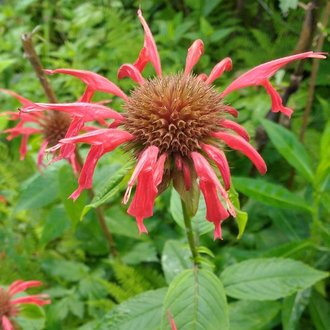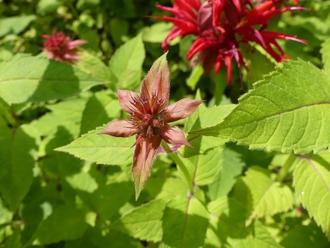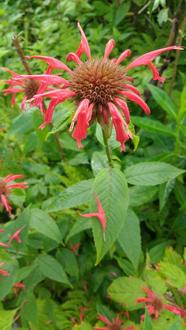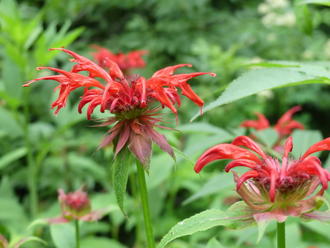Scarlet Beebalm (Monarda didyma L.)
Also known as Oswego tea, crimson beebalm, crimson bee-balm, crimson bee balm, scarlet bee balm, scarlet beebalm, scarlet bee-balm.
↑Summary
A rhizomatous perennial of moist, well-drained sites that have been recently disturbed.
↑Range - Expand
| Legend | Color |
| Native | |
| Native or Expanded | |
| Introduced or Not Present | |
| Expanded | |
| Native or Not Present | |
| Expanded or Not Present |
This tentative map is based on our own research. It may have limited data on Canada and/or Mexico, and there is some subjectivity in our assignment of plants as introduced vs. expanded. Read more in this blog post.
Although this plant occurs somewhere in each of these regions, it may only occur in a small part of some or all of them.
This species is widely cultivated in gardens; although it only occasionally escapes into the wild, it is so widely planted that it has established in numerous regions as a result. It remains uncommon in the wild in much of its new range. We mark the eastern portions of the range expanded because they are mostly contiguous with its native range, although some of the westernmost points could perhaps be marked introduced. The Washington state population is clearly introduced.
↑Habitat
In its native range, found along streambanks and in well-drained portions of floodplains, in thickets, and in moist woodland borders and openings, and also in anthropogenic habitats, including roadsides and gardens. Prefers partial sun, in moist, fertile, loamy soil, rich in organic matter, in moist to mesic conditions; can tolerate full sun on moister sites. Tolerates other soil types so long as soil is sufficiently moist and well-drained.
In New England, northeast of its original range, found primarily in anthropogenic habitats. In the Midwest, west and northwest of its native range, it is scattered and rare, but tends to be found in similar habitats to in its native range.
Humans have increased the habitat for this species through the building of roads and the creation of more openings and edge habitats in forests, and through disturbance such as periodic mowing or trimming that favors this plant and other rhizomatous perennials. Humans have also helped it to reach these new habitats by widely planting it in gardens.
↑Life Cycle
This species is a long-lived perennial that can persist for years on suitable sites. However, in wild habitats, it is usually eliminated after several years because the moist, well-drained sites it prefers usually grow up in woody vegetation and it eventually gets shaded out.
Plants reproduce vegetatively by rhizomes, forming large colonies on favorable sites. Vegetative reproduction is often more important than reproduction by seed.
We have not found any information on cold dormancy and germination of this seed in the wild, but information from nurseries suggests that this plant's seeds likely germinate after a period of cold dormancy, in late spring as temperatures warm, and fare best when on or near the soil surface. Seedlings are fragile and susceptible to drought. In the wild, some type of disturbance is likely necessary to create conditions suitable for germination. We could not verify whether or not this species' seeds persist in the seed bank; the broader mint family contains both species that form long-term seed banks and those that do not.
↑Faunal Associations
The flowers, like other long, deep red flowers, attract hummingbirds and swallowtail butterflies. There are several moths whose larvae eat this and other Monarda species; the foliage is usually avoided by mammalian herbivores due to its bitterness.
↑Uses
This plant is widely cultivated in gardens, including far outside its native range, which has helped it to expand its range. It is valued for its bold red color, and for attracting hummingbirds. Numerous cultivars exist; the 'Jacob Cline' cultivar is more widely available in garden centers than the straight species.
The leaf is also as an ingredient in herbal teas, both medicinally, and for beverage uses. The aroma of the dried leaf is similar to that of the Bergamot orange (Citrus bergamia) which is used to flavor Earl Grey tea. The plant contains Thymol, a compound named for its occurrence in garden thyme (Thymus vulgaris). This and likely other compounds as well impart antiseptic properties to this herb.
↑Related Plants
There are numerous other Monarda species overlapping with this in range; they tend to be found in drier habitats.
↑Links & External Resources
• Monarda didyma (Bee Balm) | Illinois Wildflowers (About This Site)
• Monarda didyma (Scarlet Beebalm) | USDA PLANTS Database (About This Site)
• Monarda didyma | Go Botany (About This Site)
• Monarda didyma (Bee Balm) | Missouri Botanical Garden Plant Finder (About This Site)
• Monarda didyma | Biota of North America Project (BONAP) (About This Site)
• Monarda didyma | NatureServe Explorer (About This Site)
• Monarda didyma | Missouri Plants (About This Site)
• Scarlet Bergamot | Maryland Biodiversity Project (About This Site)
• Monarda didyma L. (Scarlet Beebalm, Oswego Tea) | Digital Atlas of the Virginia Flora (About This Site)






